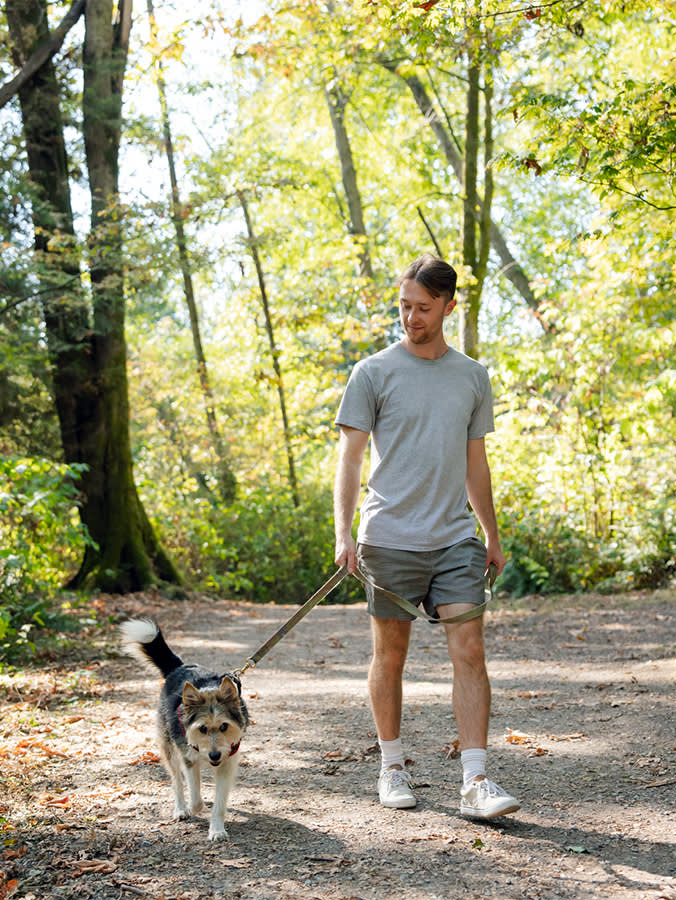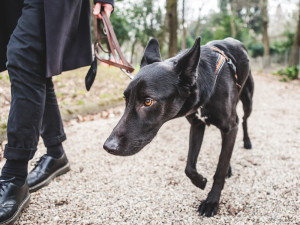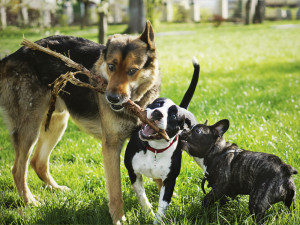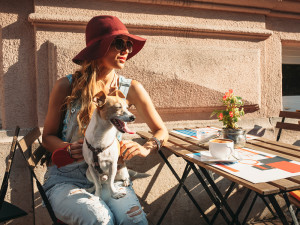How to Advocate For Your Dog in Public
How to set boundaries and protect your pup

share article
As a devoted pup parent, one of your top priorities is ensuring the safety and comfort of your canine companion, especially when out and about. Whether you’re strolling through a park or navigating busy city streets, encountering other dogs and their guardians is inevitable, but having a stressful or damaging interaction doesn’t have to be.
Navigating public spaces with your furry friend can be both delightful and challenging. Whilst many pup parents cherish the opportunity to socialise their dogs, not all pups have the same level of sociability, much like humans. Some aren’t as keen on an excited bum sniff as others, some are nervous or anxious by nature, and some are just getting used to the outside world.
Whatever their reasoning, it’s essential to advocate for your dog’s needs and safety, especially in encounters with unfamiliar dogs, people or places. Here are some expert tips on how to effectively advocate for your dog in various situations, and how to manage the dreaded “they’re friendly” shout from across the park.
Why is it important to set boundaries and advocate for your dog?
As a pet parent to a rescue dogopens in a new tab, I’ve learned the hard way that being able to advocate for your pup is one of the most valuable skills you can have in your arsenal. My darling rescue Luna wasn’t socialised properly as a pup, and was very (read: very) scared of the big bad world. Training and fear-shaping can only go so far if you’re letting them enter nerve-wracking situations on their own, and advocating for your dog can be a way of setting them up for success.
My own personal lack of confidence in this area got us into trouble when Luna was rushed by several off-lead dogs from a large dog-walking group, and her own confidence and social growth completely relapsed. It might seem a bit awkward or uncomfortable at first, but I now don’t risk any situation that could harm her, and personally do not even think twice about whether the other pet parent or dog walker will be insulted or not if I ask them to back off.
Sadly, dogs can’t speakopens in a new tab for themselves (yet), so you have to do the talking for them, and let other dogs and pet parents know what’s going on. Whether with body language or verbally, it’s essential to advocate for your dog’s needs and safety, especially in encounters with unfamiliar dogs or people.
Not only is it your responsibility and right as a pet parent to be able to enjoy your walks in the way you want to, but some incidents could seriously ruin your trainingopens in a new tab and all your hard work so far if your pup experiences a distressing situation. Ultimately, however, setting boundaries for your pup can produce some really favourable results:
It strengthens your relationship: learning how your dog feels and paying attention to their body language in different situations helps you to understand them better, and being able to show your dog that you can protect them helps them trust that you will keep them safe.
It keeps you, your dog and others around you safe: ultimately it’s not just about you. Part of being a responsible dog parent means keeping the world around you safe, too. Even the most gentle dog’s can be pushed in the wrong situation, so knowing where your dog’s limit is, is key.
It makes more adventures possible: having faith in your relationship means you’re able to tackle a range of situations in a variety of environments. Before I earned Luna’s trust, she felt the need to take things into her own hand, either by running away or issuing a warning growlopens in a new tab. Now, if she’s unsure in a situation, she can now reliably look to me for direction first.
How to set boundaries when it comes to your dog
Visible communication
Rachel Forday, dog trainer and founder of Dog At Heartopens in a new tab, suggests using visual cues to communicate your dog’s needs clearly. “One of my favourite methods of communication that can be the easiest for people to start doing comfortably is to have their dog wear a high-vis vest that communicates that they don’t want dogs around them,” says Rachel.
These vests can bear messages such as “NO DOGS”, “IN TRAINING” or “PLEASE GIVE SPACE”. To reinforce the message, Rachel recommends that dog guardians also wear similar vests, ensuring clear communication even to those who may not be paying attention to your pup. You can also get leads and harnesses with the same messaging if your pup isn’t as comfortable in a vest.
Verbal communication
Have you ever been in a situation where you’re tongue-tied, but five minutes later you know exactly what you should’ve said? Me too. In situations where other dog owners may not be mindful of the needs of your dog, it can be challenging to address the issue in the moment. Instead of risking confrontation, consider a more proactive approach and have a few phrases in your back pocket, just in case.
Remember, you have every right to ask other pet parents to control their pups if it means keeping everyone safe. Some tactics I have personally found useful include:
Focusing on what you’re doing: “we’re working on training and don’t want the distraction of your dog” or “we’re going to stay over here whilst you walk past” often feel less confrontational than blaming “you” or “your dog”.
Being open and honest: “they (my dog) can be reactive when they’re pressured by other dogs” explains clearly, for example, that you’re removing your pup from the situation for the other dog’s safety, too, and comes across as being a responsible parent (when really you want to tell the other dog to f*** off, and the other pet parent to control their pup).
Speaking clearly: sometimes it can be hard to control anger or frustration at another dog, but a simple “please can you take your dog away” or “please can you put your dog on the lead” are full sentences, and specific and clear enough for the other pup parent to understand what needs to happen to rectify the situation.
Rachel acknowledges the challenge of educating other dog guardians in the heat of the moment. “It is a challenge to effectively educate other dog guardians at the moment about the potential risks of their dogs being off-lead,” they explain. “You may be too overwhelmed with making sure your dog is OK to be able to educate and explain clearly, and the other person may not receive this well in public which may be counterproductive if it results in them feeling shame and becoming more defensive.”
Instead of attempting to address the issue on the spot, Rachel suggests arranging separate discussions with habitual offenders in a neutral setting. This allows for a calm and constructive conversation where both parties can express their concerns and viewpoints. Alternatively, leverage local community platforms such as online groups or use flyers to raise awareness about lead safety and responsible dog ownership.
Physical communication
Advocating for your dog doesn’t always need to require assertiveness or confrontation. Sometimes, the best action “can look simply like removing your dog from the situation and/or interaction without saying or explaining anything,” says Rachel. If you’re out with your dog and you see an over-enthusiastic pup bolting your way (you know the ones), “swiftly leaving the area can effectively disengage from potential conflicts,” they add.
This might mean taking the scenic route on your walk, but it’ll show your pup that you understand, and you’re here to keep them safe. If your pup is on the lead, you can keep your body between them and the oncoming pup (where it’s safe to) as an extra layer of protection for them.
Rachel suggests teaching your pup a ‘run away’ cue or, if you have a small dog, “you can absolutely carry them and leave as long as your dog is comfortable with being carried by you”. If your dog is already a master of the down stay, it can be a great tool to use when you’re not able to swerve oncoming pups. Lying down is a calming signal and is seen as submissive to other dogs, and, more often than not, the other dog will lose interest in your pup.
Put safety first
It’s essential to recognise that advocating for your dog may not always be safe. “A challenge that is not often talked about when educating people on advocating for their dogs is the fact that, in some situations, it can actually be unsafe for some of us to advocate for our dog,” explains Rachel. Dog guardians, particularly those who face marginalisation, may find themselves in precarious situations, they add. In such instances, prioritising personal safety is paramount, and self-blame should be replaced with efforts to help the dog decompress and regain composure.
Advocating for your dog in public spaces requires a combination of clear communication, education and a mindful approach to safety. By implementing these strategies and fostering a supportive environment for both yourself and your furry companion, you can navigate public outings with confidence and ensure positive experiences for all involved.
Practise self-compassion
With that in mind, Rachel underscores the importance of self-compassion, especially when learning how to advocate for your dog. You can’t always get it right: sometimes incidents happen so fast it’s hard to adapt quickly enough, and each event is a lesson in what you can do next time to protect your pup.
Remember to be kind to yourself in those moments where advocating for your dog feels challenging or impossible. Reactive behaviours from your dog, such as lunging or barking, do not reflect your abilities as a pup parent. “Instead of focusing on self-blame, work on helping your dog decompress afterwards and know that you are trying your best to keep both you and your dog safe,” adds Rachel.

Orla Pentelow
Orla Pentelow is a freelance journalist and copywriter based in London. When not at her desk she’s out and about with her rescue dog, Luna, who works primarily as chief distractor.
Related articles
![a nervous dog sits on a sofa]() opens in a new tab
opens in a new tabBringing Home A Very Nervous Rescue Dog – A Guide For Anxious Parents
At so many points in those first hours, weeks, months, I screamed, internally: what have we done?
![kneeling woman with braids training her golden retriever]() opens in a new tab
opens in a new tabHow to Find the Right Trainer, No Matter What Your Dog’s Been Through
With so many dog trainers out there that it can be hard to know who you can actually trust (especially if your dog has trust issues of their own), here’s where to start…
![Boston terrier being stubborn]() opens in a new tab
opens in a new tabDog Training: DIY or Hire a Pro?
When it’s time to call in reinforcements
![Mixed dog laying on the floor int he sun with an unsure look on her face]() opens in a new tab
opens in a new tabDecoding Your Dog’s Growls
When your dog growls, they’re expressing their emotions. A study found that you’ll probably be able to understand what they’re feeling






